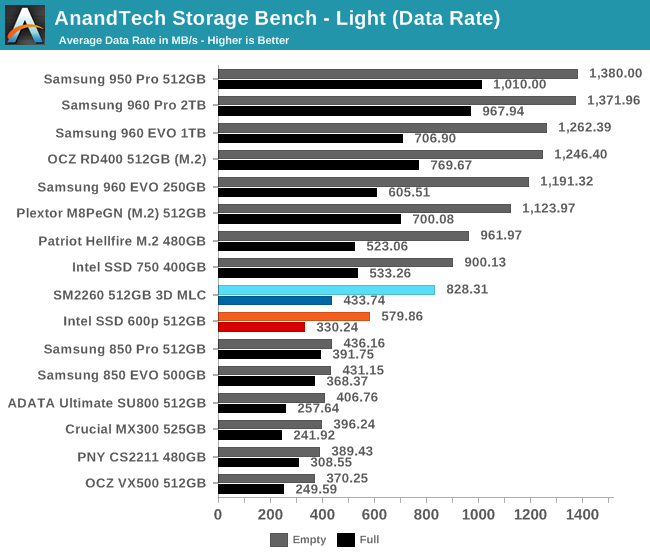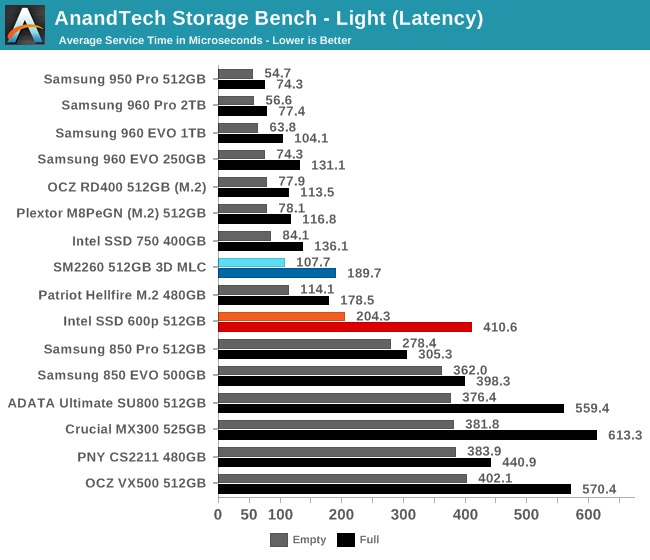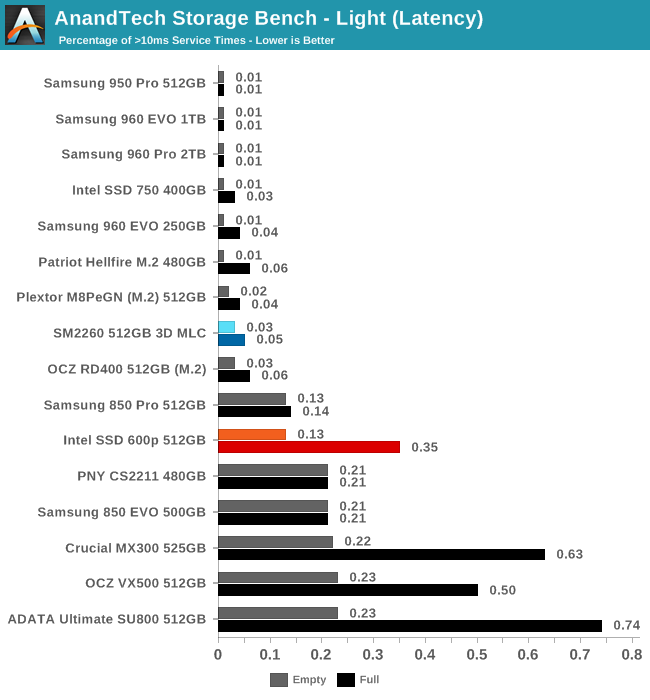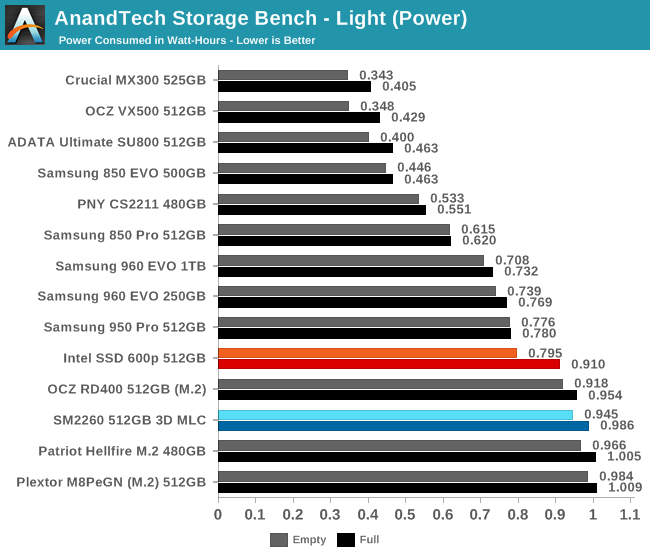Previewing Silicon Motion SM2260 NVMe Controller With 3D MLC NAND (512GB)
by Billy Tallis on February 17, 2017 9:00 AM ESTAnandTech Storage Bench - Light
Our Light storage test has relatively more sequential accesses and lower queue depths than The Destroyer or the Heavy test, and it's by far the shortest test overall. It's based largely on applications that aren't highly dependent on storage performance, so this is a test more of application launch times and file load times. This test can be seen as the sum of all the little delays in daily usage, but with the idle times trimmed to 25ms it takes less than half an hour to run. Details of the Light test can be found here.

The SM2260 sample's average data rate on the Light test once again puts it as the slowest NVMe SSD using MLC NAND, but also still faster than SATA SSDs and the Intel SSD 600p. Even Samsung's smallest 250GB 960 EVO substantially outperforms the SM2260 sample.

The average service times of the SM2260 sample put it near the bottom of its class of NVMe SSDs, but this metric also shows a wide lead over SATA SSDs.

The SM2260 sample is not in the top tier of NVMe SSDs for its ability to keep latency low, but the number of outliers above 10ms is slightly better than the OCZ RD400 and far better than SATA SSDs and the Intel 600p.

The SM2260 is essentially tied for last place in power efficiency, using only slightly less energy than the Patriot Hellfire and the Plextor M8Pe.










27 Comments
View All Comments
motigez - Sunday, February 19, 2017 - link
Honestly, at this point, TLC is the only viable technology for Client market, the incremental performance benefit you may get on MLC based SSD just don't worth it, and I expect to see little to no traction on those moving forward.LordanSS - Sunday, February 19, 2017 - link
To be very honest, a 3D MLC at 40nm has very good endurance, which would be good for a usage of heavy writes.If you're dealing with video capture and editing, it'd be a good choice over 3D TLC, even tho 3D TLC at 40nm has decent endurance as well.
leexgx - Tuesday, February 21, 2017 - link
to bad they did not continue the BX100 line as it had insane low power use (still fast enough for a low end SSD) BX200 and higher was like the worst SSD for low end SSD and power useRanger1065 - Wednesday, February 22, 2017 - link
Does anyone really care about this? The number of comments seems to indicate a comprehensive "NO." Another article, another step towards oblivion. Great job Anandtech.BrokenCrayons - Wednesday, February 22, 2017 - link
I see you're back to once again try to decry the site. It's funny if things are so bad that you keep coming back to read articles, but that's a special sort of problem, I suppose. Anyway, since you're having trouble with reading comprehension, most of the comments swirl around the drive's poor performance relative to other products. Just because someone doesn't leap to their feet to applaud a device that landed at the bottom of a chart doesn't mean the reviewer, the article, or the company publishing it is doing something wrong by reporting their test results. Just because people are generally in agreement with the results via their comments certainly doesn't indicate there's a problem with the review. You're just trying to project your silly opinion on others and hope to bend reality to your will by getting prophetic about the future...or you're trolling...probably both.BrokenCrayons - Wednesday, February 22, 2017 - link
I see you're back to once again try to decry the site. It's funny if things are so bad that you keep coming back to read articles, but that's a special sort of problem, I suppose. Anyway, since you're having trouble with reading comprehension, most of the comments swirl around the drive's poor performance relative to other products. Just because someone doesn't leap to their feet to applaud a device that landed at the bottom of a chart doesn't mean the reviewer, the article, or the company publishing it is doing something wrong by reporting their test results. Just because people are generally in agreement with the results via their comments certainly doesn't indicate there's a problem with the review. You're just trying to project your silly opinion on others and hope to bend reality to your will by getting prophetic about the future...or you're trolling...probably both.watzupken - Saturday, February 25, 2017 - link
So far, the Silicon Motion and Phison's controllers always seem to perform poorly with consistency. They don't seem like they are trying to fix it with each iteration of their controller.